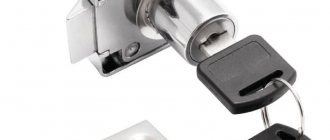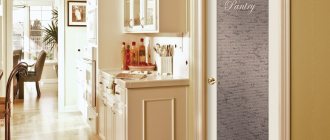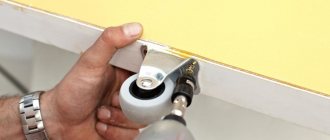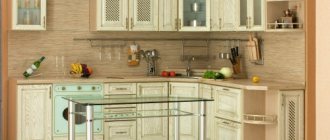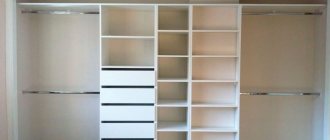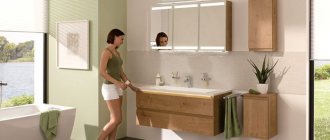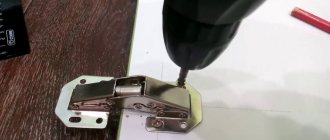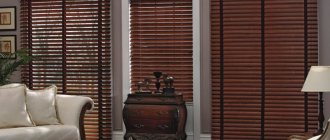0
18408
A furniture lock is used to securely store and hide household items or accessories, or high-value papers from prying eyes. This type of fittings is available in various forms and has different functional features.
Features of choosing and installing furniture locks
Installation of a furniture lock usually occurs at the factory. Most types of furniture are equipped with this function: most often these are cabinets, furniture fronts, table drawers. A lock can be useful not only to prevent anyone from getting into the contents of the drawer, but also to prevent cabinet doors from opening on their own, for example, if the furniture is not level. It is quite convenient and looks aesthetically pleasing.
What is a furniture lock? Types of products
When choosing a lock, it is important to consider the thickness of the furniture doors; The method by which the installation will be carried out also plays a significant role, since different types of locks may require insertion or do without it.
Furniture fittings and locks can have different designs and are made from various materials, lightweight and durable. After all, for furniture it is important that the device not only protects against burglary, but also looks decorative.
Cabinets with locks are no longer a rarity; they will help protect things from a thief if he breaks into the apartment, secure the doors, and protect the contents of drawers and shelves from curious small children who might eat or spoil something.
Child locks on furniture are usually simple in design; an adult can open them without difficulty, but children will not be able to cope with such a task. This will protect not only things, but also the child himself, if, for example, breakable objects are stored in the closet that could cut the child. Such locks are sometimes called postal locks. They should not be confused with small hinged ones, which are used to protect the mailbox. The types of locks are as follows:
- Mechanical: common, opens with a key.
- Electronic: - to open, you need to dial a code.
- Magnetic: requires a special key to open. It closes using a magnetic field and requires electricity to operate.
Devices and installation methods differ. The following types are distinguished:
- The most common furniture lock is the mortise lock. Often used for wardrobes and other types of furniture, it is not noticeable, does not take up space and does not interfere with the opening of doors.
- The second most popular are rim locks. Most often they are installed on glass doors, since it is not possible to embed a lock into them, but the opening of the doors will be limited. Fixation occurs using bolts; in this case, the glass will have to be drilled. Magnets are used less often, and then drilling is usually not necessary.
In addition, simple locks that are easy to open can be used. They protect cabinets from children and spontaneous opening. Such devices include:
- Latch lock.
- Child lock.
How to choose?
When choosing a lock, first of all you should pay attention to what it is made of: the reliability and durability of the product, as well as the safety of things in the event of a break-in, depend on the quality of the material.
In addition, pay attention to the design of the product and the installation method, since the lock is selected individually for furniture made of different materials. For example, an element designed for a wooden product cannot be installed on a glass door, and vice versa.
You also need to take into account the way the doors open. Most products are suitable for swing doors, but for sliding doors you will have to look for a device that will not interfere with opening and can secure the doors. A wide range of affordable furniture fittings is presented on the website https://chifu.biz/mebelnaya-furnitura
Installing a zip lock on furniture
Installation of such products is usually not difficult. If you have the tools, you can install a furniture lock on the cabinet yourself. To do this, you will need to have a drill, a special Forstner drill, if you don’t have one, you can replace it with a feather drill. It doesn't hurt to have a screwdriver, a piece of plywood and something to use to mark the material.
Finishing touch
The service life of a lock depends, first of all, on its quality: the better it is assembled, the stronger the material, the longer the lock will last. Good locks, in addition, should not change their color or fade, that is, they should have a high-quality coating.
Also, when purchasing a lock, you should pay attention to how smoothly the mechanism works, and most importantly, the key from one lock should not fit another. Manufacturers of quality locks have thousands of different combinations to avoid this situation.
You can familiarize yourself with all of the above lock models in more detail in the electronic catalog or in the MDM-Komplekt office, where professional managers will show you each model in action and choose the best option for you.
Come and choose “Locks worthy of your furniture”!
Yours, Fedor Konfirmatov
In the modern world, anyone can afford to buy a wardrobe. The only difference in the products is the quality of the material from which it is made. You can order it from a good craftsman who will make, in your opinion, an individual sketch and take into account all your wishes.
To choose a lock and not make a mistake with your choice, you need to pay attention to the details.
In the modern world, anyone can afford to buy a wardrobe.
You can order it from a good craftsman who will make, in your opinion, an individual sketch and take into account all your wishes.
Those who have small children face the problem of clutter, because children love to play.
Every closet has doors that must be closed, so there must be a lock.
Devices are:
- half embedded;
- fully built-in.
Those who have small children face the problem of clutter, because children love to play.
Product characteristics:
- big and small;
- complex and simple;
- have a wide variety of colors (gold, copper, matte nickel, bronze).
A closet lock helps solve this problem by locking the doors in the open and closed positions.
Any installation does not take much time, and with high-quality production it can last a long time.
The advantage of any lock is that it should perfectly cope with its intended function.
The disadvantage may be poor-quality production and short-term operation due to unexpected breakdown. This causes inconvenience in future use.
Any installation does not take much time, and with high-quality production it can last a long time.
Before you decide to buy a lock for a sliding wardrobe, you need to study all the characteristics and, if possible, check the mechanism.
This causes inconvenience in future use.
What is a stopper
A closet stopper is a device that helps fix sliding doors in the right place on the guide rail. Owners of closets with two sliding doors do not particularly need stoppers, but if there are 3 or more doors, the need for this device is extremely necessary, because after each opening, you will need to install all the doors (3, 4, 5) evenly, and this takes time and it doesn’t always work out the first time. This happens because without stoppers there is free movement along the lower rail.
Installation
Installation or replacement of the device in a sliding wardrobe can be done in a few minutes. All you need to do is place it in the recess of the bottom guide. How many stoppers are needed depends on the actual number of sliding doors. Installation does not require much effort.
How to install?
Anyone can install the device independently, without the help of specialists. For this:
- Before the guide is attached to the cabinet, we insert a stopper into the recess from the end of the line.
- With the bifurcated parts facing up, we pull it into the track to the place where the door wheel is planned to stop.
- Then we screw the rail to the guide.
Closer for sliding system
This is a whole system that includes stoppers, limiters, latches and other elements so that the doors automatically close smoothly and are comfortable to use. Every third model requires several closers at the same time due to the need to close the doors in different directions. Adapters that regulate the operation of the system are installed in the upper part of the cabinet, and the closer is installed in the upper part of the guide yard.
It is worth noting another significant role that is controlled by the automatic system - security. This device minimizes the likelihood of injury when closing the cabinet abruptly.
In addition to providing safety to the owners, the structure itself has an increased level of protection against loosening. This opportunity arises due to the shock-absorbing effect that is introduced into the automatic door closer systems.
To select an automatic closer system, you should pay attention to the following factors:
- dimensions and weight of the wardrobe;
- directions for closing and opening the sliding system;
- material of manufacture of the system itself (aluminum structure or steel).
The installed systems are in demand and extremely popular due to the fact that they combine:
- Ease of use. You just need to push the door and it will smoothly close on its own. Children or pets will not be able to do this. The effort that needs to be made is not noticeable for an adult, but for children even an animal will cause difficulties.
- Aesthetic appearance. The door is always in the right position and closed for a fee.
- Safe to use. When closing the doors, neither children nor pets will be harmed. Often when playing, children can sharply push the door, and the system slows it down 5-7 centimeters from the wall itself and slowly closes it, preventing injury and damaging the cabinet body.
- Reliability. Steel and aluminum structures allow the mechanism to be used for a long time.
You can learn how to install a stopper with a shock absorber on a sliding wardrobe from the video.
Choosing a pen?
For the sliding system, you can choose a handle that will have the most suitable design. All existing varieties differ from each other in individual details, and therefore which option ultimately turns out to be acceptable will depend on:
- Design features of the door;
- Doorway size;
- Dimensions of the door leaf;
- Sash material;
- Personal preference.
All handles are mortise, and their handle is most often an ordinary recess used to open the sash.
Independent models
These handles got their name because they are not connected to any locking mechanism. Their design does not imply the installation of any kind of lock or elementary latch. If it is necessary to fix the sash in the closed position, to the leaf and side wall. The force generated must be sufficient to prevent the closed sash from moving.
Attention! If the door installation was carried out according to all the rules, you can safely refuse such a handle.
Independent model
The popularity of independent handles is due to their:
- Fairly simple design;
- Low cost;
- Easy to install.
Most often these are mortise products placed inside the sash during installation. The handle does not extend beyond the door leaf, which makes it possible to open/close the door even with limited surrounding space. This model is suitable for cassette sliding systems, which can be completely hidden in the wall during the opening process. The installed handle in this case greatly facilitates the process of operating the door system.
Mortise with latch
This handle is initially equipped with a locking mechanism that allows you to open and close the latch when the need arises. In terms of their design, such handles are similar to models installed on swing doors, but they have some differences.
Firstly, the handle is made much smaller. Secondly, the latch comes out of the hole in the strike plate after turning a small handle or moving the slider. Both options assume that the parts used to open the door are located in a special recess on the door handle. As a result, the installation of such a handle is possible on doors that are used in limited conditions, for example, on cassette doors.
Handle with lock
This model differs from previous versions by the presence of a special hole designed to accommodate a keyhole. Manufacturers offer models that already have a cylinder of a locking design built into the handle, adapted to the operating features of the sliding door.
The need to protect furniture
A small child finds everything that happens around him interesting, so situations often arise that threaten the baby’s health. The time when children begin to crawl and walk is considered especially dangerous, since the danger will be from sharp corners and doors of furniture, sockets, and household appliances. Young children especially actively begin to explore the world from the contents of the closet and shelves. Some things can be removed or moved higher, but the sharp corners of tables, sofas, chairs, and drawers remain.
Even if you protect sharp furniture elements, the question arises regarding the contents of cabinets, cabinets, and drawers. The baby can open the door and easily get to small items, dangerous devices and valuables, and medicines. Therefore, it is important to take care to make it difficult for a child to penetrate into pieces of furniture.
To reduce the risk of injury to a child, caring parents resort to tricks - installing protection, limiters and blockers. Sometimes such devices are made independently, but a more reliable option is special products that can be purchased at hardware stores.
Types of blockers
There are several main types of blockers. The difference lies in the method of attaching the device to furniture and the features of their functioning. There are Velcro-type blockers and permanently mounted ones.
Main types of door locks:
- Locks are interlocks that lock onto handles from the outside. The device securely closes the door leaves, which helps protect the contents from damage and the baby’s fingers from injury. The mechanism of the device is a plastic cord with notches, which are fixed with a special attachment. The handles are braided with cord and closed with a “lock”. The advantage is that adults can easily open the mechanism, but children cannot;
- a universal lock connecting the door of a cabinet or chest of drawers to the body. The mechanism is a silicone strap, which is secured with clasps on the sides. The advantage lies in the versatility of the fixation, since it can easily be used on drawers and doors where there are absolutely no handles;
- shock absorbers blockers - devices of this type are made from elastic and at the same time durable materials: plastic, foam rubber, rubber, silicone. It does not close the door, but, on the contrary, does not allow it to open completely or close completely. Thus, the baby will not be able to nail his fingers. A shock-absorbing blocker is installed in the upper part of the door;
- locks for sliding doors, for example, for sliding wardrobes. Often the device is made of plastic, and its mechanism completely replicates the design of the door, where the strap is secured with a special fastener. It is impossible for a child to cope with the mechanism, but for an adult it is easy to open the door with such a lock;
- internal lockers are mounted on screws and are a retractable structure that will not allow opening a chest of drawers or cabinets. In addition, this detail does not attract too much attention from the child and does not spoil the appearance of the furniture.
It is better to choose blockers and other security elements that do not stand out against the background of the overall design of the room, so that they do not attract too much attention from the baby. There are blockers for other needs - fixing plastic windows, a device for limiting door locks. The main thing is to choose the right device for the corresponding door or drawer.
How to install it yourself
Installing a furniture lock will be quite feasible for most users. The greatest difficulty is the installation of a mortise structure. Procedure:
- The necessary tools are being prepared. You will need an electric drill, a Forstner drill or a pen drill (the first is better), a ruler, an awl, and a screwdriver.
- Marking is being done. Usually a diagram is attached to the lock, which is placed on the door and the centers of all holes are marked. If there is no diagram, you need to accurately determine the dimensions and mark the drilling points on the sash. They are marked with an awl to leave indentations for centering the tool.
- The necessary holes are made. As a rule, you need a through one for the mechanism and several blind ones for fasteners, although there may be other options.
- The lock is fixed, a decorative ring is put on the cylinder.
- Next, focusing on the position of the part, the installation location of the counter structure is noted. It is attached to a fixed part of a cabinet or table.
Scope of application of furniture nails, varieties in shape, size
The last step will be to check the functionality of the product and adjust the response bracket, if necessary. As a rule, you need to slightly bend the corner to achieve the desired result. After this, the installation is considered complete, and normal operation of the lock begins.
Tools are being prepared
Marking is being done
Holes are drilled
The lock is fixed
A counter structure is being installed
